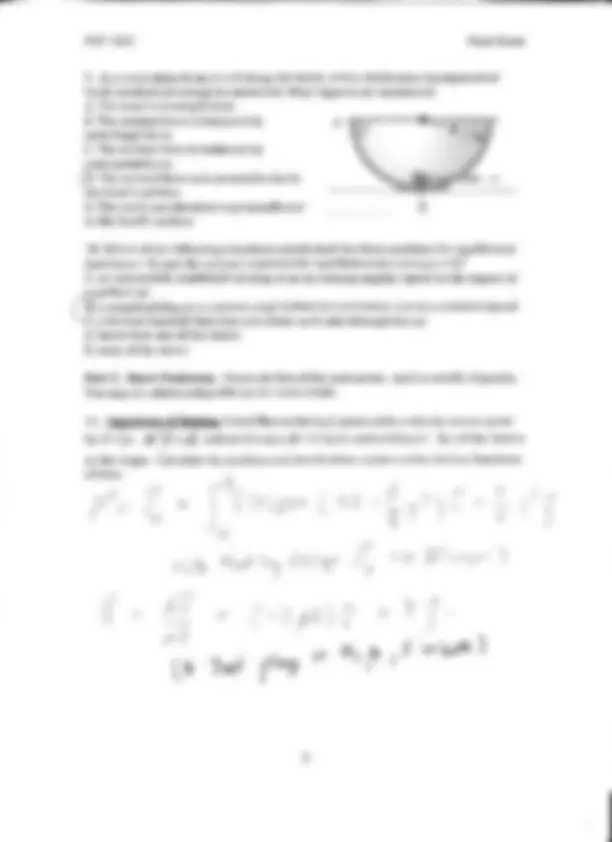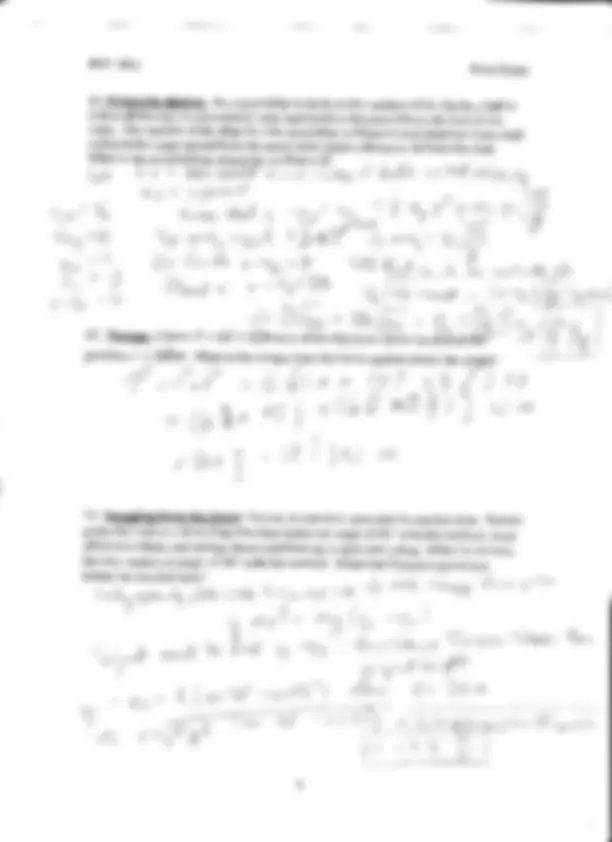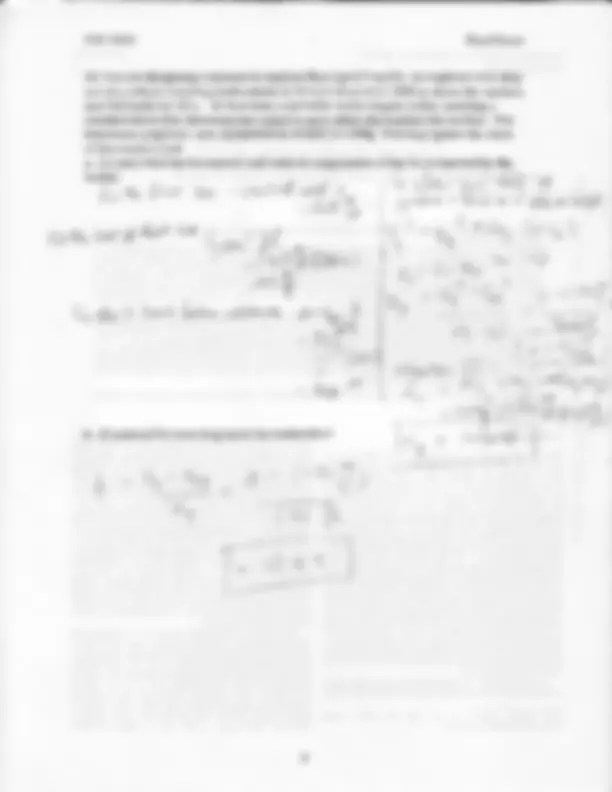






Study with the several resources on Docsity

Earn points by helping other students or get them with a premium plan


Prepare for your exams
Study with the several resources on Docsity

Earn points to download
Earn points by helping other students or get them with a premium plan
Community
Ask the community for help and clear up your study doubts
Discover the best universities in your country according to Docsity users
Free resources
Download our free guides on studying techniques, anxiety management strategies, and thesis advice from Docsity tutors
Material Type: Exam; Professor: Perlman; Class: Physics 1; Subject: Physics; University: Florida Institute of Technology; Term: Unknown 1989;
Typology: Exams
1 / 8

This page cannot be seen from the preview
Don't miss anything!





a/4\
Practice Final Exam. Pleasedo all of the following problems. (^) You are allowedto havea formula sheet,calculatorand ruler. Pleaseshowyour work
Part I. Multiple ChoiceProblems. Eachquestionis worth 6 points,
{ D)I/2 asmuch. 4^ t/+ as much.
,.@
aoeszero work on the satelliteat all points^ in the orbit.
PHY1OO1 Final^ Exam
na = l.00kg ns :^ 3'00kg
A. the weight of the ball B. the normal force exertedby the ramp
. The answerdependson whether the ball rolls without slipping.
B.An object is initially at rest.A net force^ fwhich alwayspoints in the same direction) is appliedto the objectso^ that the power^ of the net force^ is constant.As the obiectgainsspeed, A. the magnitudeof the net force remainsconstant. /&.\themagnitudeof the net force^ increases.
{-6. { CJtnemagnitudeof the net force^ decreases. not enoughinformation given^ to decide
table. The captainof the ship (^) flies the spaceshipto PlanetX and observesthat a ball rolled at the samespeedfrom the sametable landsa distance3d from the foot. What (^) is the accelerationof graviWon planetX? ["ei + ;;-'W,"";,X;rW""i';';;^,,:i*t6^ ,{ 1,"6sl eL;h4.vL{dc,V *ul =^ '^-?t{wd (^) ' A W
Vot tD^ Sr; <-xD* ttaxt +Mt-'
'
fir :Y ^
C,n[oufi^ x-u =b^ n6Tottru ,14h^ uutt^ ) 4,[ " 'A Qw* ^ y<Ka33b --
" (^). l**,,, \
,f]#o =h^
\YtfiA^turK' :;
Vrizhew.f (^) {ro-{oL#{":l;t
13'rorque.AforceF =(ai+Ej)rv".rrJ,r0u?objectata[ointto.i{Ari,f"D}'"Jt"f1-'rtr^ i position ; = 1e[1t. What is the torque that this force (^) appliesabout the origin? .J*-:-l
A.
-J
PHY1OO1 (^) Final (^) Exam
1'2.Proiectile Motion. On a spaceshipin dock on the surfaceof the Earth,a ball is rolled off the top of a horizontaltable and landsa distanced from the foot of the
L4. Swinging from the Trees Tarzan,in one tree, (^) seesfane in anothertree. Tarzan grabsthe end of a 20-m long (^) vine that makesan angleof 45owith the vertical,steps offhis tree limb, and swingsdown and then up to give (^) fane a hug. When he arrives , his vine makesan angleof 30" with the vertical. Whatwas Tarzan'sspeedjust beforehereachedfane? , I u,*i r'^i *D^ +^
,,,lvl,t-a+,wv4r-^ q'iu Ord.r hrav, ! A8-4ur\yfu^ *^ ttlni lqa!
t (^) i-t ,u,-ol h (^) ftA (^) i, -'lr'- -4*6l11ta",ee
Tr'tz** f\ln<v^ 1L."
J
'^v
Vr!;^*!
l*" J
') (^) v,) zgQ Lut=^
L-i..,
*?q d:f,|
Ln'z,--e
i..,.","..'..-****-.4;.
PHY1OO1 Final^ Exam
ftt,.u,;''f,F, (^) "1"?
ud** l0=
Mt{uq'}*%uuit"4od
=-)yvrilu^ %,',- 'ku?,,u',,-l#r,.s,r| '-Y=H,^ T,:^il _-( '[]x,0'*){r^rd}
"J-j; -!
i
'',
''offi fr#ffi9'id,ltf;E*rhff;,ffi^ -{oq
miles per hour on a level road. If this car makesa 200-km^ trip, [a) how many^ joules of energydoesit consume,and (b) what is the averagerate of eners/ consumption onthetrip. Assumethatlgallonofgasolineyieldsl.3xlOef. f, n.. tr tlt_l*s ^ 4t / -\ n d^ [l t-^ {rwldn (^) Luryt;"u,,rnl
j' I '" t'"
(al 4* yo,i
= (^) i) r^tuu*tor,^ t 'r J
'' , *! k/ wt yt ';^ ry' t:
4t
o"-il* = z.49r$
,?c,0Vz-wt
fial.tur.a
,+ga,
-)
Arrl= (4,r
"tZ{W;
o*;'wi
= l?r{ vr*,r' '-ffi;, (^) ,- 4,1\3d,
)P^,=y^ , 2uo1,J,s,z uv w*l5e A+ ?q{as
3^{)({,b(,olt,"Jddtj
o: '" (^) :' O tb) A'f'^ v"t)^
*',-ify Qil
tzL
9=e s( .13 al
vo
'%
n*p
ln
:=r-.t l,Ff "l r
= (^) tLA 'l ,'# ] I
I GJT Lq #u!l",fr.'
up /
rb 5r^ " : gZq f.-.'- I,,w
j (^4) g4ansl
PHY1OO1 (^) Final Exam
aJ (10 points) What is the averageaccelerationfin m/sz) of the shuttle during [i) the first 8.00^ s and (ii) between8.00^ s and 1 min?
Au 5
i'-t:q
ur s
Jt*n
"Ltu,hz at"ffi
^
'
(,54 5a
rs r 's' 1k"
I t,.\tVr t uA/ r^& (^) ( uou-'**tq42'a T)"ru (^) tznlL--vy1r/
'-t*
I
rr"Iu 9
t ,n=
(^5) )(:c.,*, ]- '{t/?t7{ - (^) r" )"u br^ /\
;: qr
{i;} - /)vL\i^ - /t/',t7,2-L/v,71-7\
=77qu
b) (B^ points) What is the altitude of the spaceshuttle after 1 min?
Do,f 'l,Jury'^ to + Qq,7zg
/c ) 1-10'l-. z, (^) At;r fr afirit''' ('^
Jt1{t'*r):w' lv \rz I
Cr., *g^ 'iCI
s
llt ' (^). o.\ r I {sz,o
}=l,zt
\ t-t^^ qJfd,{efuJF/c ttetl'.&"'rffirr'* d
celrs'
g ft# r",ft"4.r*d
,wd fo w( (=U^ r,:4rc{o',"'J.7&WP'w"t
(fr'qo {*fuift'td^
J't* }
7
a'i) i-'lo" W
,/+lw
6osl")c
o{
,1t* hh{ c'|r.f-;o rq{ft(** af tt-^^ trt',(,,1t 5pso4*
Uo I ulvulntw,^#
-*
'ln,i,',* ftu r"r,-it
vr*#v"t ?,
[6 points) Canyou calculatethe force required to attain these^ accelerations, given the information in this problem? Why or why not?
( \wu
PHY1OO1 Final Exam
20.You are designinga missionto exploreMars (g=3.7m/sz).An exploreris to step out of a vehicletraveling horizontallyat 33 m/s when it is 1200 m abovethe surface, and fall freely for 20 s. At that time, a portablerocket beginsto fire, exertinga constantforce that decreasesher speedto zero when shetouchesthe surface.The total mass(explorer,suit, equipment& rocket) is 150kg. You may ignorethe mass of the rocket'sfuel. a. (13 pts) Find the horizontaland vertical componentsof the force exertedby the rocket. i**^ $tt,^ zos 'ltlf"^ f-Stf ;r :
So s/'l{ lnre^ (U g;gf-^e&
b. [9 points) For how long mustthe rocket fire?
L
= '[
ul; D (^) ?]'r#;
n '@} ^t'l {,Et p.
S olw zot *uff h{
rZ ertn - ?i# r$q^ 4fu *\WW
Af{tue,r{d*"r"
ro (^) ,r,M,,plU**,trars
) =7'l *
o{-,Jo, J =?'ty: - (^) {';r}$
*?d&ffi
); =,JryuY&e?{v-Iu\
V,,' (^) ') t 4.
5c) '-)
^'u
*rln,,? fi - r
njcnub.n-[f ' '";-": wor** =xG
, 1 ltsIWf:1-!elrr
i*t
= iusof- |